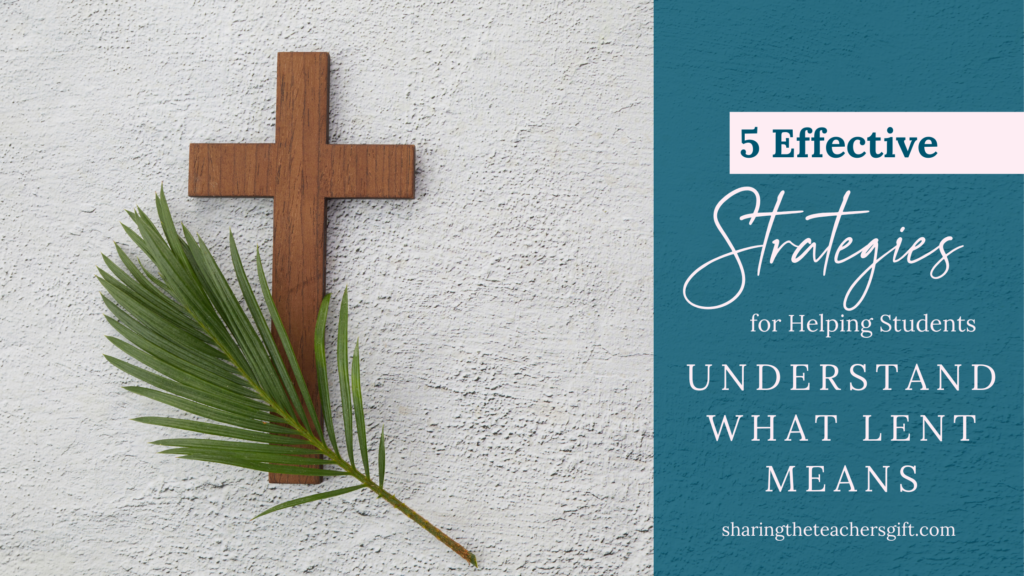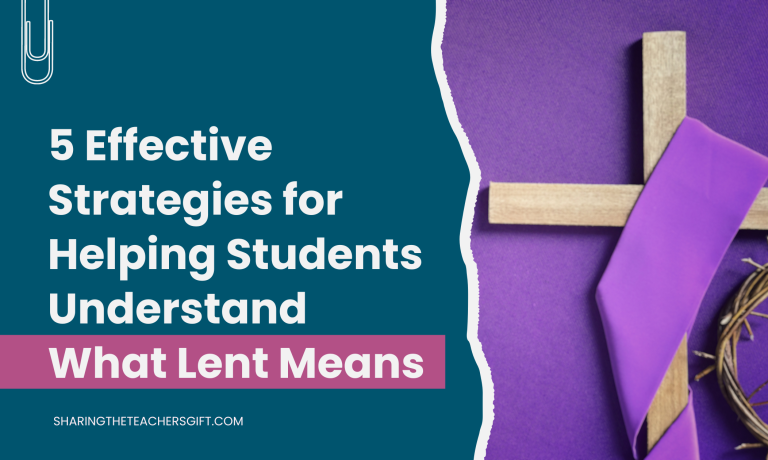What Lent Means for Catholics
To understand what Lent means, it’s important to recognize its position within the Liturgical calendar. So, let’s dive in! Lent is the fourth season in the Liturgical Calendar. It follows Advent, Christmas and the first season of Ordinary Time. It is a time of penance and preparation as we await the summit of our faith: Christ’s Resurrection, through which he conquers death and sin once and for all, and restores the hope of everlasting life.
Mirroring Jesus’ time of prayer and fasting in the desert and his selflessness, we are called to a true conversion of heart and to follow Christ more faithfully by reorienting our lives to him. We do this by cleansing ourselves spiritually through repentance and reconciliation and preparing for his resurrection through prayer, fasting, almsgiving during the Lenten season.
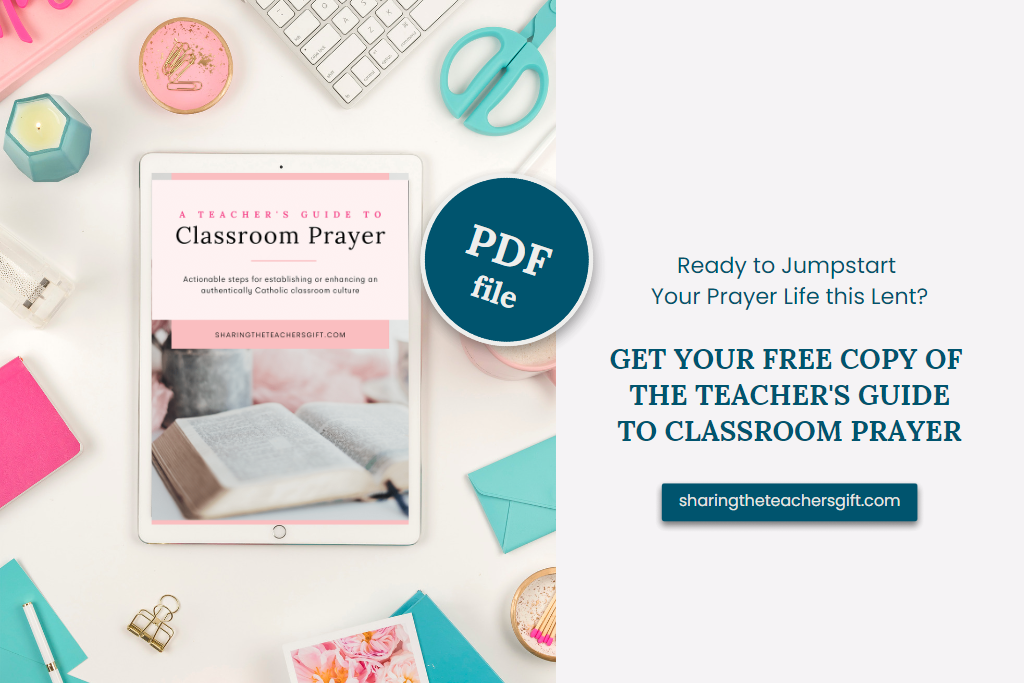
How Many Days for Lent?
The word “Lent” comes from the Middle English word “Lencten” meaning “spring”. Prior to being called “Lent”, the season was simply called “Forty Days”: “Quadragesima” in Latin or “Tessaracoste” in Greek.
The designation of 40 days for the Lenten season, as a rule in the practice of the faith, is first observed in the Canons of Nicea (A.D. 325). The 40 days are primarily a reflection of Jesus’ 40 day fast from food and water in the desert following his baptism, during which he was tempted by the Devil. Emerging victorious in conquering Satan’s temptations at the end of this time of prayer and fasting, Jesus begins his public ministry.
The 40 days are also reminiscent of the 40 years the Israelites spent wandering the desert in search of the Promised Land. During this time, God provided for their every need. While the journey certainly did not need to take 40 years, the behavior of the Israelites during their time in exile indicated that they were not yet worthy of the Promised Land. As such, the 40 years of waiting became a time of purification while the Israelites prepared to receive the gift of the Promised Land.
For us, the 40 days of Lent are also a time of preparation. Beginning on Ash Wednesday and concluding on the evening of Holy Thursday, our Lenten journey of 40 days (excluding Sundays) is a time of preparation. During this time, many faithful Christians take up and give up certain practices as a means to prepare more fully to celebrate Christ’s Resurrection at Easter.
How to Have a Good Lent: Prayer, Fasting and Almsgiving
With Lent beginning in just two weeks time, it is a perfect time to start thinking about how to have a good Lent. The years that I have put together my Lenten plan for prayer, fasting and almsgiving in advance of Ash Wednesday have been my best and most fruitful.
Conversely, the years that I found myself still trying to decide what to give up and what to take up well into the first week of Lent have proven to be the most challenging. One year, I even found myself unable to receive the Eucharist on Easter Sunday because I had failed to prepare through participation in the Sacrament of Reconciliation.
Throughout the Lenten season, we are called to align ourselves more fully with Christ. We can do this through prayer, fasting, and almsgiving. These are known as the three pillars of Lent. Creating a plan for how you will live out these three pillars during the Lenten season is a great way to ensure a good Lent.
Your plan should include:
- Prayer: What practice you will take up to improve your prayer life?
- Fasting: What you will sacrifice (give up, fast from) to move towards greater holiness? and
- Almsgiving: How you will share your time, talent and/or treasure with others?
- Reconciliation: When and where will you go to Confession?
As teachers, it is important to consider and construct our personal Lenten plans. We should also take some time to consider how we will help our students to live this liturgical season well.
Read if You’re Asking What to Do in Lent with your Students
If you’re wondering what to do in Lent with your students, I’ve got you covered. It’s really not rocket science: prepare yourself and then prepare them using some of the very same strategies. Basically, the most effective way to guide your students through Lent is to live Lent well yourself and to take time to teach and guide them in preparing for and living liturgically through the Lenten season as well. Doing so will help your students not only come to an academic understanding of the season of Lent but establish a practical, personal process for living the season in a manner that draws them closer to Christ, in anticipation of His resurrection at Easter. By preparing yourself well, you will show, by your life, that living and growing in faith in this time in history is possible – and, that in itself, is powerful!
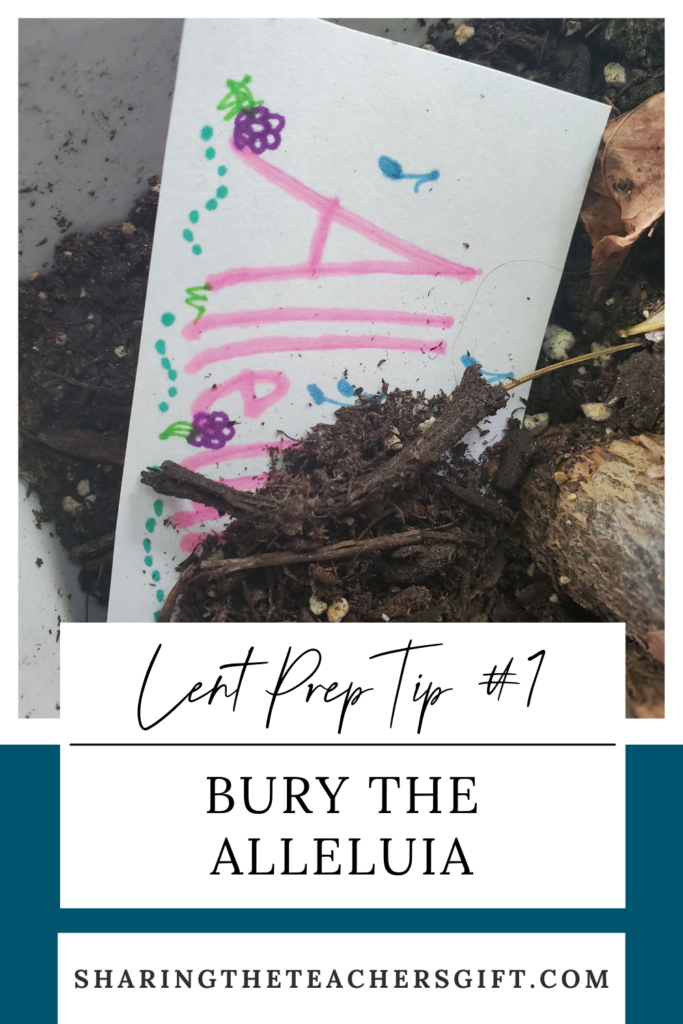
5 Traditions to Teach your Students What Lent Means
Now that we’ve addressed the foundation for an effective Lenten season: make a plan, follow the plan, and invite your students to do the same, let’s speak to some practical hands-on strategies you can use in the classroom to help your students understand what Lent means.
Strategy #1: Bury the Alleluia!
Set the stage for the Lenten season by taking time on the Monday or Tuesday before Ash Wednesday to bury “Alleluia” in your school garden or somewhere similar and invite your students to do the same with their families at home.
The word “Alleluia” means “Praise the Lord.” and is a joyful proclamation that is used regularly in worship throughout the majority of the year. It is heard and said in the prayers of the Mass and included in many of the hymns and songs sung in Mass and at other prayer services.
During Lent, however, the alleluia is removed from the liturgy completely. It is put away or “buried”, laid in the tomb so to speak, until it re-emerges triumphantly in the liturgy with Christ’s resurrection at Easter. This sets the tone for and is in line with the solemn nature of the Lenten season. It can also be viewed as one of the first acts in preparation for the Lenten season, in that burying alleluia represents our first fast of the upcoming Lenten season: a fast from using the word “alleluia”.
Burying the alleluia with your students might look like having the class create or decorate a beautiful Alleluia to bury in the school garden. It could also look like inviting each student to design their own beautiful alleluia to bury. In doing so, you may wish to consider burying the alleluia(s) in a plastic container of some sort to ensure that it remains when it comes time to dig it up again at Easter. If burying the alleluia(s) in the school garden is not feasible for whatever reason, you could simply have students place their alleluia(s) in a beautiful box to be stored away until Easter.

Strategy #2: Pray the Sorrowful Mysteries of the Rosary
The rosary is a powerful prayer centered on the life, passion, death and resurrection of Jesus Christ. The Lenten tradition of praying the sorrowful mysteries of the rosary provides an engaging way for students to meditate on Christ’s passion and death.
Providing students with a context for the sorrowful mysteries and either scripture or another reflection to meditate on while praying, brings to life and makes each mystery of the rosary more personal. The sorrowful mysteries pick up immediately following the Last Supper, during which Jesus washed the feet of his disciples, broke bread with them, initiated the Eucharist and the priesthood, and foretold his betrayal.
He has now invited some of his disciples to join him in the Garden of Gethsemane where he will pray for the strength to endure what is about to transpire and where, ultimately, he will be betrayed and handed over to the authorities by Judas, with a kiss. From here, the sorrowful mysteries take us through Christ’s scourging at the pillar, crowning with thorns, carrying of the cross, crucifixion and death.
All in all, praying the sorrowful mysteries of the rosary with your students is a practical hands-on, minds-on way to prepare your students for Holy Week.
Looking for some helpful resources? For those of you who teach upper elementary and/or middle school, you might find these resources helpful for easily implementing the practice of praying the rosary with your students: Rosary Booklets, Guide on How to Pray the Rosary, and The Sorrowful Mysteries Rosary.
Strategy #3: Help Your Students Create a Lenten Plan
Beginning the conversation about the season of Lent before it begins, discussing its importance and the pillars of Lenten practice, will provide an excellent foundation for students to build their personal plans for prayer, fasting and almsgiving during the Lenten season.
It is common for students to simply associate giving up something like chocolate with Lent. Providing instruction on the three pillars of Lent and giving a variety of suggestions the type of prayer they may choose to take up, the type of fast that is beneficial for leading them closer to Christ, and expanding the concept of almsgiving from simply donating money to include acts of service can all help students to have a truly impactful Lent.
Some examples of prayer practices students could consider taking up include:
- praying the rosary or a decade of the rosary daily,
- waking up 30 minutes earlier each morning to spend that time in prayer with God,
- reading the daily Mass readings or committing to reading a chapter of one of the Gospels each day,
- spending time in adoration (either in person or online), or
- making a list of gratitudes each day and praying to God in thanksgiving for each of their blessings.
Encouraging students to carefully consider what they are choosing to “give up” or “fast from” for Lent is also beneficial. A good fast will lead them closer to Christ in some way. It may unite them to Christ’s suffering because it’s a challenge to give up whatever it is they have chosen for their fast from. Fasting from a sinful habit is also another great choice for growing in holiness throughout Lent.
Finally, almsgiving can include giving money to a worthy cause that has some significance to the student and/or their family. However, it can also include giving of time or talent, such as:
- Volunteering for a local charity,
- Spending time with an elderly relative,
- Making a commitment to take on an extra chore to help around the house, or
- Offering to babysit, occupy or entertain or occupy a younger sibling.
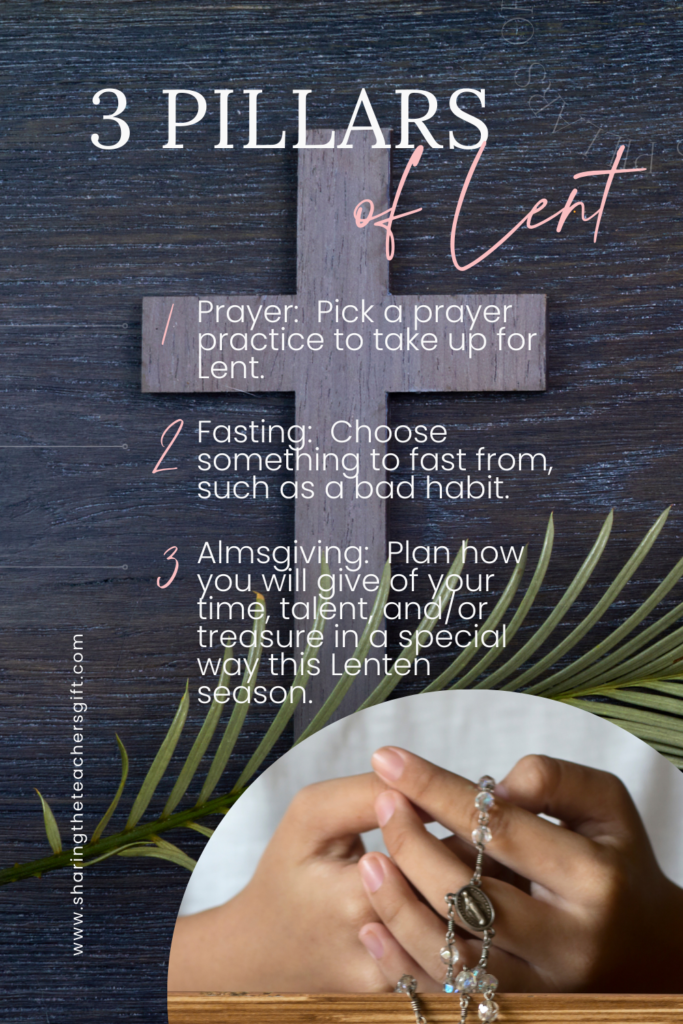
If you’re looking for a ready-to-teach, easy-to-implement approach for helping your upper elementary or middle school students draft their Lenten Plan, grab the 3 Pillars of Lent lessons here or the entire Lessons About Lent Bundle here.
Strategy #4: Take your Students to Confession
Participating in the Sacrament of Reconciliation is one important way we can reorient our lives to God during the Lenten season as we prepare to celebrate Christ’s Resurrection at Easter. By making a good confession, we are able to repent of our sins and reconcile ourselves to God.
The importance of participating in this Sacrament during Lent is highlighted by the Church’s efforts to make the Sacrament of Reconciliation more available and accessible. Oftentimes, parishes will offer additional times for Confession throughout Lent. Churches will also usually host penitential services at which several priests are available to hear confessions.
School leadership will often work in conjunction with the parish priest to coordinate a time for the students to attend confession during the Lenten season. As a classroom teacher, you can help by preparing your students in advance. Reviewing the purpose, structure and form of the sacrament is helpful. Taking time to guide your students through a thorough examination of conscience will assist them with preparing to give a good confession.
Resources for guiding students through this process can be found linked below.
Strategy #5: Participate in Stations of the Cross
Praying the Stations of the Cross (or the Way of the Cross) with your students is another great way to help them reflect on Christ’s passion and death. It will also help them prepare to celebrate His resurrection more fully and with great joy at Easter. Most parishes will provide opportunities for the laity to pray the Stations of the Cross as a community on Friday evenings.
Some schools also take time during the Lenten season to come together as a community to pray the Stations of the Cross. Some schools also provide an opportunity for some of the students to lead the prayer service as lectors or through a dramatized version of the Way of the Cross.
If this is not the common practice of your school, you might consider suggesting it. Otherwise, taking time to pray the Stations of the Cross with your students in class is beneficial, too! Resources for praying the Stations of the Cross with Children and Teens can be found linked below.
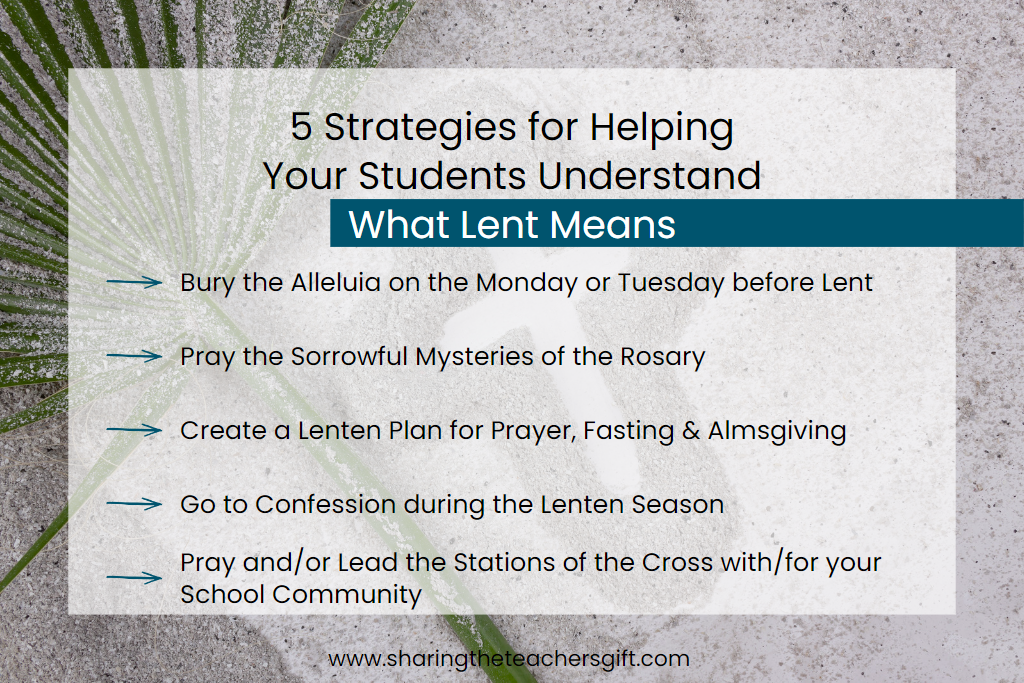
Related Articles/Resources
Here are some other resources, curated from a variety of Catholic websites, that you might find helpful in preparing your students to celebrate Lent this year:
- Catholic Activity: Farewell to Alleluia by Catholic Culture
- Stations of the Cross for Children by Loyola Press
- Stations of the Cross for Teens by Lifeteen
- Confession Guide for Children by the National Catholic Register
- Guide to the Sacrament of Reconciliation for Middle School Students by Christ the King Church & School
Looking for some strategies for boosting your prayer life or your classroom prayer practice this Lenten season? Grab your free copy of the Teacher’s Guide to Classroom Prayer right here:
Closing in Thanks
Thank you so much for spending this time with me! I hope you found this article helpful as you prepare to celebrate the Lenten Season with your students. Be sure to check back soon for new blog posts related to teaching the Catholic faith!
Always praying for you and cheering you on!
Courtney
P.S. Looking for resources to help you with teaching the Catholic faith, ELA or easing the behind the scenes of teaching? Check out my TPT Store! Need help with Classroom Management, Parent Communication or Lesson Planning? Check out my course, S.A.I.N.T.L.Y. Classroom ManagementTM on Podia!
References
Charbonneau, Matt. “Lent 101: What Every Catholic Should Know.” Ascension Press Media, 27 Feb. 2020, https://media.ascensionpress.com/2020/02/21/lent-101-what-every-catholic -should-know/.
“Lent Draws Us Closer to God.” The Roman Catholic Diocese of Phoenix, Diocese of Phoenix, 25 Feb. 2021, https://dphx.org/lent/.
Pope Francis. “MESSAGE OF HIS HOLINESS POPE FRANCIS FOR LENT 2022.” The Vatican, Dicastero per La Comunicazione – Libreria Editrice Vaticana, 24 Feb. 2022, https://www.vatican.va/ content/francesco/en/messages/lent/documents/20211111-messaggio-quaresima2022.html.
“The Sacrament of Penance.” Code of Canon Law, The Holy See, https://www.vatican.va/ archive/cod-iuris-canonici/cic_index_en.html.
“What Is Lent?” USCCB, https://www.usccb.org/prayer-worship/liturgical-year/lent.
